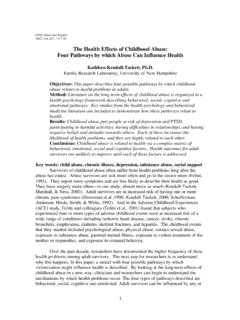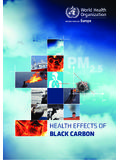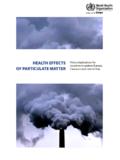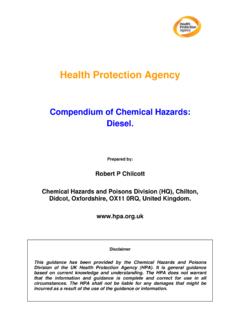Transcription of Occupational Exposure to Respirable Crystalline …
1 1 Occupational Exposure to Respirable Crystalline Silica -- Review ofHealth Effects Literature and Preliminary Quantitative RiskAssessmentOccupational Safety and health AdministrationDocket OSHA-2010-00342 Occupational Exposure to Respirable Crystalline Silica -- Review of health EffectsLiterature and Preliminary Quantitative Risk AssessmentTABLE OF CONTENTSI. health Effects Literature Background Information on Crystalline Silica and the Literature Background and Terminology for Measuring Worked Exposures to Dust Current Methods for Measuring Respirable Crystalline Methods Used for Collecting Dust Concentration Data for Dust sampling Estimation of the percentage of silica Clinical and Epidemiological Considerations in Assessing Workers atRisk of Developing Clinical features of Chest radiography and other imaging techniques to assess silicosis Pulmonary function testing (PFT)
2 Review of Surveillance Silicosis Silicosis Underreporting of surveillance Progression of Silicosis and Its Associated Factors influencing radiological progression of Relationship of progression to pulmonary function Pulmonary Preliminary Conclusions: Silicosis and Disease Effects of Silica (Cancer of the Lung and Other Sites) Evaluation of Cohort Danish stone industry granite shed and quarry crushed stone industry Finnish granite Chinese refractory brick Italian refractory brick South African gold Western Australia gold gold Chinese tin and tungsten British Coal North American industrial sand United Kingdom industrial sand United Kingdom pottery Chinese pottery Dutch ceramic German stone and ceramic diatomaceous earth industry Danish foundry (Michigan)
3 Foundry Chinese iron and steel Swedish aluminum foundry Norwegian silica carbide Canadian silica carbide Finnish road paving and asphalt Canadian bricklayers and associated Pooled IARC Sponsored Multicenter Exposure -Response Analyses forLung Multi-National Pooled Population and National Death Certificate Studies national (27 states) case-control Finnish nationwide job Exposure matrix (FINJEM) European multi-center community-based case-control Studies of Lung Cancer Risk Among Preliminary Conclusions from the Lung Cancer Overall and industry sector-specific Smoking, silica Exposure , and lung Silicosis and lung cancer Relationship between silica polymorphs and lung cancer Cancer of Other Cancer of the larynx and Gastric (stomach)
4 Esophageal Other miscellaneous Nonmalignant Respiratory Summary and conclusion for Chronic Summary and conclusions for Pulmonary Function Summary and Conclusion for Pulmonary Function Nonmalignant Respiratory Disease Summary and conclusions for NMRD Preliminary Conclusions for Other Nonmalignant Respiratory and Autoimmune Renal Autoimmune Preliminary Conclusions for Renal and Autoimmune Factors That May Influence Toxicity of Crystalline Mechanism of Relationship between silicosis and lung Toxicity of Crystalline Freshly Fractured vs. Aged Human Discussion and Metal Impurities/Clay Preliminary Conclusions for Factors Affecting the Toxicity of Conclusions261II. Preliminary Quantitative Risk Cancer Risk Steenland et al.
5 (2001a) Pooled Cohort Rice et al. (2001) Analysis of Diatomaceous Earth Attfield and Costello (2004) Analysis of Granite Kuempel et al. (2001) Assessment Based on a Lung Dosimetry Hughes et al. (2001) Analysis of Industrial Sand Miller and MacCalman (2009) Analysis of British Coal Summary of OSHA s Estimates of Lung Cancer Mortality and Non-Malignant Respiratory Disease Mortality Risk Mannetje et al. (2002b) Pooled Park et al. (2002) Study of Diatomaceous Earth in Lung Cancer and Silicosis Mortality Risk Selection Exposure Measurement Lung cancer uncertainty analysis303 Monte Carol analysis of error in the assignment of individualexposure values303 Monte Carlo analysis of error in estimating exposures to silicafrom historical dust concentration data305 Monte Carlo analysis incorporating both types of measument error 306 Sensitivity analyses of biased conversion Silicosis mortality310 Monte Carlo anayses incorporating two types of randommeasument error310 Potential effects of random measurement errors on silicosismortality risk Assessment of Renal Disease Assessment of Silicosis Morbidity Definition of Summary of Silicosis Morbidity Cross-sectional Cumulative risk studies
6 With little or no post-employmentfollow Cumulative risk studies with post-employment follow Summary of Risk Related to Assessing Crystalline Silica-Related Choice of Cumulative Dose as the Dose Physical Factors That May Influence Toxicity of Crystalline Conclusions350 Appendix A: Life Tables Used for Assessments of Lung Cancer, Non-MalignantRespiratory Diseases, and Renal Disease Mortality Rate360 III. Response to Peer Review Review of the health Effects Literature Review of the Preliminary Quantitative Risk Effects Literature Background Information on Crystalline Silica and the Literature is comprised of silicon and oxygen (SiO2) and is one of the most abundantcompounds on earth. It occurs in either a Crystalline or non- Crystalline (amorphous) silica, in which the silicon and oxygen atoms are arranged in a tetrahedron structure,exists in several forms, or polymorphs.
7 The most commonly encountered polymorph is quartz;crystobalite and tridymite are two other naturally-occuring polymorphs of Crystalline silica. Theimportance of the Crystalline feature is that it is highly stable, insoluble in water, and possesseson its surface reactive oxygen species when fractured (Castranova et al., 1996). The presence ofthese reactive species on the crystal surface is largely responsible for the toxicity of crystallinesilica particles when inhaled. OSHA currently enforces an Occupational Exposure limit forrespirable dust that contains quartz, as well as for Respirable dust that contains crystobalite is a common component of rock and soils. Consequently, workers are exposed toquartz-containing dust when performing operations that disturb or break up soils and rock, ormaterials derived from them such as concrete and masonry.
8 Crystobalite and tridymite are alsonaturally occurring but to a much lesser degree than quartz. These polymorphs are formed fromquartz that has been subjected to high temperatures. Work operations that involve subjectingquartz-containing materials to high temperatures may cause quartz to morph into crystobalite,resulting in worker exposures to dusts containing hazards associated with Exposure to Crystalline silica-containing dusts arise fromthe inhalation of the Respirable dust fraction, which is comprised of particles sufficiently small toreach the deep lung. The Respirable fraction is broadly defined as particles having a diameter of10 m or less (IARC, 1997). It is this portion of Crystalline silica-containing dust that is of mostconcern to OSHA and is the focus of this health effects section.
9 The Occupational diseasesassociated with inhalation of Respirable Crystalline silica and discussed in detail in this sectioninclude: silicosis and other non-malignant respiratory diseases; pulmonary tuberculosis; chronicbronchitis with airflow limitation, and emphysema (both more commonly referred to as chronicobstructive pulmonary disease, or COPD); and several extra-pulmonary diseases (renal andimmunologic) and cancer (lung and other). These Occupational diseases, either alone or inconcert, are life-altering and debilitating disorders that annually affect thousands of workersacross the United States. Many of these diseases are also life-threatening. The preponderance ofevidence for the adverse health effects associated with inhalation of Crystalline silica, asdescribed extensively in the scientific literature consists of studies of exposed , many animal andin vitrostudies have also been conducted in an effort to elucidate themechanisms by which Crystalline silica increases the risks of adverse health purpose of providing an extensive review of the scientific literature in this healtheffects section is to present OSHA s preliminary findings on the nature of the hazards presented8by Exposure to Respirable Crystalline silica, and to present an adequate basis for the quantitativerisk assessment section to follow.
10 The health effects section is organized by type of disease withsilicosis addressed first, in Section next section, Section C, deals with the carcinogenic effects of inhalation of respirablecrystalline silica which have been investigated in numerous epidemiological studies, almost alldealing with workplace exposures. The section mostly focuses on studies of lung cancer but alsoincludes discussion of suggestive evidence that Exposure to silica may increase the risk ofesophageal cancer and possibly other cancers. In addition to the OSHA analysis, theInternational Agency for Research on Cancer (IARC) has concluded that there is sufficientevidence of lung carcinogenicity in humans exposed to Crystalline silica (IARC, 1997).Section D discusses and evaluates the scientific literature describing emphysema, chronicbronchitis, pulmonary function impairment, and other non-malignant respiratory diseases.















